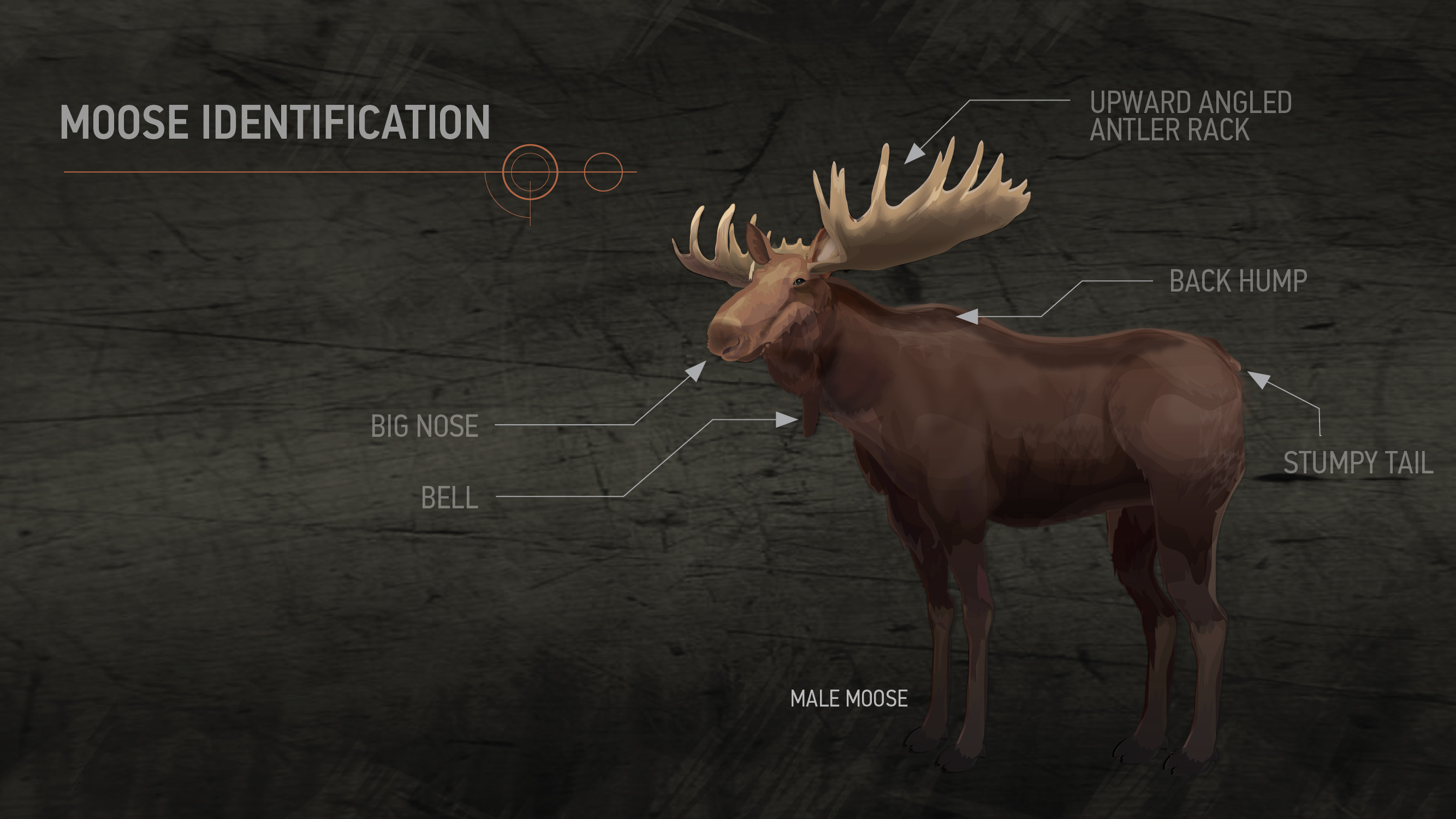HUNTINGsmart! USA Knowledge Base
Module 10 - WILDLIFE
MOOSE


If there was a category for HUGE game animals, moose would be in it. Bullwinkle is the big daddy of the deer family.
Identification
Moose are large and prehistoric-looking. They’re dark brown in color (sometimes even a blackish color). They have large noses and a distinctive hump in their back. Male moose have a large, wide antler rack that angles upward (each antler looks like the palm of a hand facing upward). Moose also have stubby tails and a ‘bell’—a fleshy piece of skin that hangs under their chin like a beard.
Be careful when identifying moose—they lose their antlers every year so it can be easy to confuse a male (bull) with a cow (female). Additionally, this big game animal can weigh up to 1000 lbs. Be warned, it’s no small feat to transport a moose once its down. Be prepared to do some heavy lifting.
Diet
Moose are vegetarians. Despite their impressive size and strength, they aren’t predators out there. In fact, they don’t even have teeth on their upper jaw. They munch on woody, leafy plants for the most part like willow, dogwood, maple, and birch. They also have a tough, thick tongue, which they use to strip the leaves off of entire branches at once. In the summer these guys frequently feed on aquatic plants and will actually submerge their entire head underwater to get at what they want. For this reason, moose are often found snacking in swampy areas. This is where you should be hunting for a moose.
Habitat
Moose prefer northern climates and spend most of their time in cool, shady, forested areas. In the summer weather, they’ll hit the local ‘splash pad’—swamps, lakes, bogs—anywhere they can chew on plants and cool down at the same time. Don’t forget about this when you’re hunting—moose do NOT like the heat, so if the sun is beating down and you’re looking for a bull, you should be looking for a cooler spot.
Cool fact: Despite their size, moose are actually really good swimmers. Watching them power their 1000 lbs. across a lake is an amazing sight.
Scat
Moose scat looks like deer scat (pellet piles) except that moose dropping will be bigger and rounder in shape. Fresh scat will be dark brown in color and shiny. Older scat will be yellowish in color and fibrous. If it’s shiny and there’s some fly activity around it, you can bet there’s a moose in the area. So find the splash pad and you’ll likely find your bull.
The Rut
During the rut (beginning in late September), bulls get really aggressive. They will thrash through the forest and break tree branches with their wide antler rack. The striking sound that this activity produces establishes their dominance to other bulls in the area.
In the weeks leading up to the rut, bulls begin to spar with each other, locking their antlers together, then pushing and shoving until one bull submits. Sparring is how bulls establish their dominance, assess their own strength and assess the strength of their competition. Hunters can recreate this sparring sound using real or fake moose antlers. Do it right and you can bring a competitive bull to your location.
Moose Calls
Every moose has a different type of call sound, so you have a little freedom there. However, there are two general sounds that you should know:
The ‘Grunt’: This is a throaty, grunting sound made by bulls. It compares to a weird, loud hiccup. The ‘grunt’ is how bulls announce their presence and challenge the other bulls in the area. Make this ‘grunt’ sound during the rut.
The ‘Cow in Heat’: This is the sound a cow makes when she’s ready for partner up with a bull. A very good lure during the rut, this moaning sound should have duration of 6-10 seconds when you try to reproduce it.
Firearms, Ammo & Your Target
A bolt action, lever action or semi-auto action will all get the job done. However, a semi-auto will have the least amount of recoil, which will make a difference when moose hunting because you’ll need to use higher caliber ammo to bring down an animal of this size. You’ll feel the punch this firearm/ammo combo will deliver. Despite the recoil factor, most moose hunters prefer a bolt action for its reliability and overall strength. Cartridges that can be used for hunting elk, bear or deer (the best for packing the punch needed for deep penetration) will also cleanly kill a moose.
Bowhunting? An accurate shot with a compound bow or crossbow and sharp broadhead arrows will do the job.
Vital Zones

With a moose, we’re talking about hitting the heart, lungs and liver. The vital zone is where the highest concentration of blood vessels will be located. This is important—you want your bullet or arrow to cause hemorrhaging so that the moose dies quickly and cleanly. The ‘quartering away’ shot is your best option for moose hunting. This is when the moose is facing away from you at a 45° angle and is stepping slightly forward. This position exposes the vital zone area that is covered by the shoulder blade when the moose is standing still. Don’t aim directly for the shoulder because the bone and muscle in that area is really thick. Your bullet or arrow would be unlikely to penetrate it deeply enough to kill the moose quickly.



